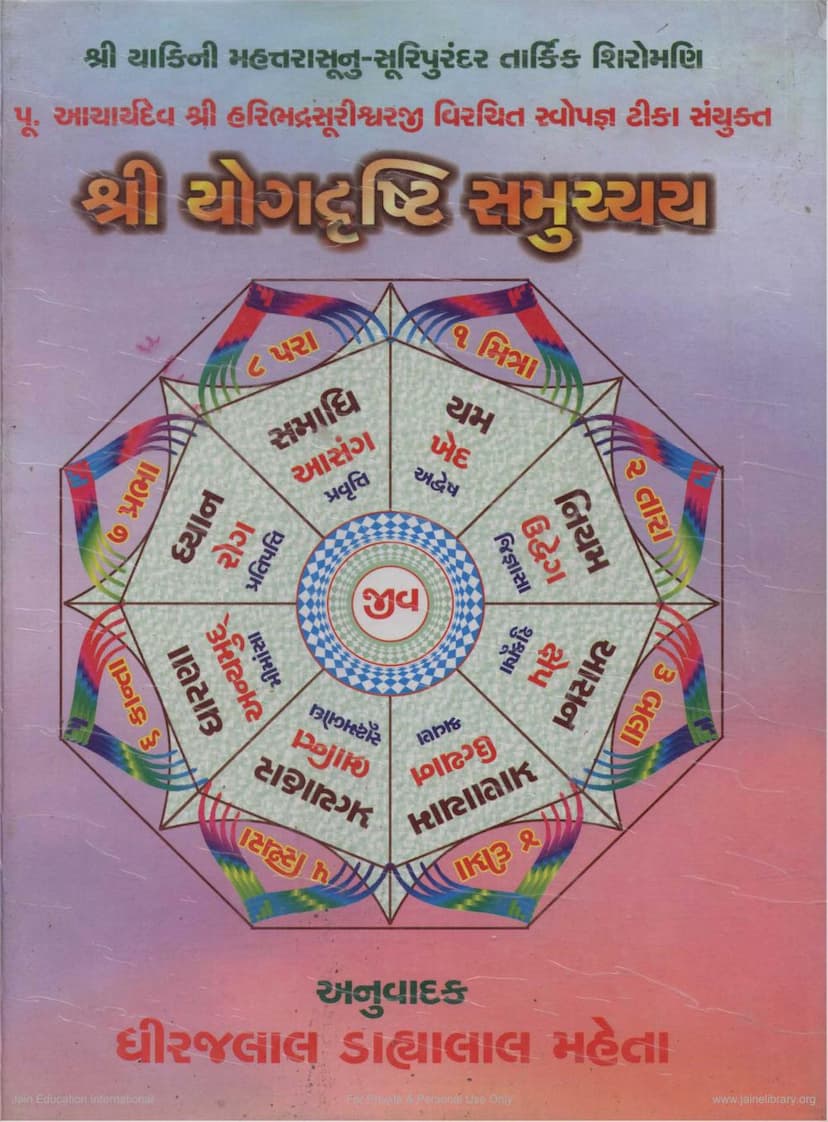Yogadrushti Samucchay
Added to library: September 2, 2025

Summary
This comprehensive summary of Haribhadrasuri's Yogadrishti Samucchaya, based on the provided Gujarati text, outlines the core teachings of this significant Jain philosophical work. The summary is structured to reflect the progressive spiritual journey described in the text, highlighting the author's profound insights and the text's enduring relevance.
Title: Yogadrishti Samucchaya (Collection of Views on Yoga) Author: Acharya Shri Haribhadrasuri Translator: Dhirajlal Dahyalaal Mehta Publisher: Shri Jain Dharm Prasaran Trust, Surat
Overview:
The Yogadrishti Samucchaya is a profound Jain text authored by the renowned scholar and saint Acharya Haribhadrasuri. The text, presented with his own commentary, is a comprehensive guide to spiritual progress and the understanding of "yoga" in the Jain context. Acharya Haribhadrasuri, a former Brahmin and royal priest who later embraced Jainism, is celebrated for his vast literary output and his ability to synthesize philosophical ideas. This particular work is considered a masterpiece for its detailed explanation of spiritual development through eight stages of 'drishti' (views or perspectives) on yoga. The book's popularity is evident from its rapid sale and continued demand across various Jain sects and even among non-Jain scholars, indicating its universal appeal and profound philosophical depth.
Core Concepts:
-
Definition of Yoga: The text defines yoga as that which "connects the soul with liberation." It emphasizes that yoga is not merely a physical posture but a process of internal spiritual development that leads to the shedding of karmic matter and the manifestation of the soul's inherent qualities.
-
Two Paths of Sukh (Happiness):
- Kam-sukh (Sensual Happiness): Derived from the pursuit of wealth, women, and worldly pleasures. This happiness is temporary, dependent, produces delusion, causes afflictions, and leads to rebirths in lower realms.
- Moksha-sukh (Liberation Happiness): Derived from the cultivation of soul qualities through the practice of the Three Jewels (Ratnatrayi) – Right Faith, Right Knowledge, and Right Conduct. This happiness is eternal, independent, devoid of delusion, and leads to liberation from the cycle of birth and death.
-
The Eighty Drishtis (Eightfold Perspectives on Yoga): The central theme of the Yogadrishti Samucchaya is the elucidation of eight progressive spiritual perspectives or stages that lead to liberation. These are:
- Mitra Drishti (Friendly View): Characterized by an initial, even if small, inclination towards spiritual well-being, leading away from worldly attachments. This stage involves the practice of the five Yamas (restraints) and fosters a sense of detachment from the cycle of rebirth.
- Tara Drishti (Star View): A progression where the spiritual inclination becomes more focused.
- Bala Drishti (Strong View): Further development where the spiritual discipline strengthens.
- Deepra Drishti (Luminous View): A stage of enhanced spiritual insight.
- Sthira Drishti (Firm View): Attaining Right Faith (Samyak-darshan), corresponding to the fourth stage of spiritual progress (Gunasthana).
- Kanta Drishti (Beloved View): Characterized by partial (Desh-virati) and complete (Sarva-virati) abstinence from worldly actions.
- Prabha Drishti (Radiant View): Progressing through the higher stages (8th to 12th Gunasthana), where proficiency in yoga (Samarthya Yoga) is attained, marking the beginning of the path to the destruction of karmas (Kshapaṇa-shreni).
- Para Drishti (Supreme View): The highest stage, representing the attainment of Samadhi, the second form of Samarthya Yoga, and ultimately the state of Kevala-jnana (omniscience) and the practice of Yoga-Sanyas, leading to the final stage of liberation (Moksha) and the Unoccupied (Ayogi) state.
-
Types of Yoga: The text discusses three main types of yoga:
- Ichha Yoga (Yoga of Desire): Characterized by a desire for liberation and spiritual growth.
- Shastra Yoga (Scriptural Yoga): Following the teachings of scriptures and guidance from enlightened gurus.
- Samarthya Yoga (Yoga of Capability/Potency): The highest form, where the practitioner's own spiritual strength and realization lead to liberation.
-
Key Themes and Discussions:
- Ogha Drishti vs. Yoga Drishti: The text contrasts the worldly-oriented 'Ogha Drishti' (mundane view) driven by sensory pleasures and the spiritual 'Yoga Drishti' that leads towards liberation.
- The Nature of Happiness: It distinguishes between fleeting sensual happiness and the eternal, inherent bliss of the soul.
- Rejection of Materialism: The text critiques the pursuit of temporary worldly pleasures and highlights their transient nature.
- The Importance of Detachment: Emphasis is placed on cultivating indifference towards worldly enjoyments and attachments.
- The Role of the Guru: The guidance of a true Guru is highlighted as essential for spiritual progress.
- Disposal of Non-Beneficial Elements: The text advocates for discarding superficial reasoning ('shushk tark' – dry logic) and focusing on practices that lead to genuine spiritual development.
- Reconciliation of Philosophies: Haribhadrasuri masterfully integrates concepts from various Indian philosophical schools, including Samkhya and Yoga, within the Jain framework, demonstrating his encyclopedic knowledge and commitment to universal wisdom.
- The Eightfold Path of Yoga: The text intricately details the eight stages of yogic practice, elaborating on their associated yogic limbs (angas), virtues (gunas), flaws (doshas), and their progression through the spiritual stages (Gunasthanas).
-
Commentaries and Translations: The book includes the author's original commentary ('Sva-opajña Teeka') and highlights various other commentaries and translations, underscoring its significance in Jain literature. The Gujarati translation by Dhirajlal Dahyalaal Mehta aims to make these profound teachings accessible to a wider audience.
Significance:
Yogadrishti Samucchaya is highly regarded for its systematic and progressive approach to spiritual development. It serves as a practical manual for aspirants seeking to understand and progress on the path to liberation. Acharya Haribhadrasuri's clear and profound exposition makes complex spiritual concepts accessible, offering guidance for cultivating inner purity and realizing the soul's true nature. The text emphasizes that spiritual progress is a journey, marked by gradual development through different perspectives, each leading closer to the ultimate goal of Moksha. The emphasis on the interconnectedness of views and the progressive cultivation of spiritual awareness makes this work a cornerstone of Jain yoga philosophy.